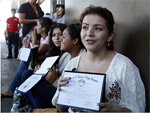ARRIAGA, Mexico -- Wilson Coxaj, looking braver than his 16 years appear to merit, left his village in Guatemala's highlands earlier this month and is making his way to the United States. It is a perilous journey.
If he's successful, he'll join what U.S. officials are calling "the surge" -- the dramatic increase in children flooding across the U.S. border, creating what President Barack Obama calls an "urgent humanitarian situation."
Coxaj, whose thick black hair and short stature denote his Mayan roots, spoke with the determination of someone needing to provide urgent economic support for his single mother and younger brother. He said he would find his way alone.
"I am not with a coyote," he said, referring to the paid human traffickers who usher some people northward. "I'm just trying to guide myself through instinct."
Children from the northern tier of Central America and from Mexico are flooding into the United States -- 47,017 from Oct. 1 to May 31, the Department of Homeland Security says -- cramming Border Patrol stations and forcing U.S. officials to set up temporary facilities for the children at military bases in Texas, Oklahoma and California.
Nearly all the children are crossing the border at the southernmost tip of Texas, U.S. officials say, meaning they travel through Mexico's lawless Tamaulipas state, an area under the firm control of organized crime. The only likely way for them to do so is to travel with coyotes working in collusion with crime groups.
Republican lawmakers have blamed Obama for the influx, saying lenient enforcement of immigration laws and the holding out of potential amnesty is drawing migrants from Central America, particularly children looking to be reunited with a parent already in the United States.
"President Obama is responsible for this calamity," Sen. Jeff Sessions, an Alabama Republican, said earlier this month.
But visits to a temporary Catholic-operated shelter in Mexico City and permanent ones in Ixtepec in Oaxaca state and Arriaga in Chiapas state indicate that the cause of the influx is far more nuanced, and that much of it is driven not so much by U.S. policies as by the turmoil in Central America that propels people to flee north.
Street gang activity in Honduras, El Salvador and Guatemala, which respectively have the world's No. 1, No. 4 and No. 5 highest homicide rates, compels youths who refuse to join the gangs to flee.
"In my colony of Montreal [in the El Salvador capital of San Salvador], the Mara Salvatrucha dominates the streets, and they wanted me to join them to sell drugs," said William Alberto Molina, who left his country last year at age 17 and has remained in Mexico. "They don't give you an option. The only option is to leave the country or join the rival gang."
"Violence in Central America is pushing these kids out," said Wendy Young, executive director of Kids in Need of Defense, a Washington-based group that provides pro bono lawyers for minors facing immigration hearings.
"This is more refugeelike than immigration," she said. "Even if kids are reunifying with family members [in the United States], that's what refugees do, too."
Honduras, which sits astride a major drug trafficking corridor from the Andean region, has seen part of its north coast turn into a lawless no man's land.
In the Catholic shelters that provide free lodging and meals to those traveling across country borders, workers say they aren't seeing much of an increase in minors traveling alone.
"There are maybe five a week," said Carlos Bartolo Solis, director of the Casa del Migrante, a shelter in Arriaga, the nearest point to the Guatemalan border where people can climb atop freight trains heading north.
"What has increased are children aged 10 to 12 who are traveling with their mothers," said Rene Vigne, a Frenchman who works at the Hermanos en el Camino (Brothers on the Path) shelter in Ixtepec.
He scoffed at reports that the number of unaccompanied children had surpassed some 6,000 a month crossing into the United States.
"There's no avalanche of minors," Vigne said. Doing a back-of-the-envelope calculation that some 180,000 people arrive in Mexico every six months, Vigne added: "Are you telling me that nearly one in four is an unaccompanied minor? That's stupid. That is pure fantasy."
But a diplomat from Central America based in Arriaga, who spoke on condition of anonymity because he didn't have permission from his head office, said many of the children travel in groups under the custody of coyotes, staying in safe houses rather than shelters, out of sight of the employees of Catholic shelters.
"We counted on one train that there were 75 minors on board," he said, referring to the freight line known as La Bestia, or "The Beast," atop which thousands of people hitch a ride every few days.
The diplomat said few minors are like Coxaj, the 16-year-old literally alone on the journey. Most are in groups under the control of an adult.
"These kids aren't alone. They go accompanied by someone," he said.
Once they get near or across the border, he added, the groups disintegrate.
For his part, Coxaj said he wants to find work in the United States to send money back to his single mother and little brother. His U.S. destination is unclear. He knows the names of only New York City and Los Angeles. Yet he was confident that he'll find the kind of job that eluded him in his Central American homeland.
"For a factory job [in Guatemala], you need school certificates," he said. "I only completed second grade, so it's difficult for me to get those jobs."
A Section on 06/19/2014

